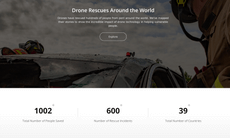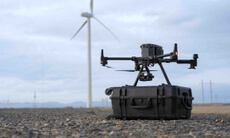
Phantom 3 by Laurie Rubin
Is there anything better than spending time with your family and friends, an open fire crackling nearby, sharing stories from the year gone by? Or the excuse to indulge in some casual gluttony at special Christmas dinner with recipes passed from generation to generation? And let's not forget the all important Christmas tree and the presents underneath!
Many of you are going to be receiving a DJI drone this holiday and we want to make sure you know how to get the best out of your new companion. These eight tips will get you set up and ready so your first flight is as amazing as you've imagined it.
1. Inspect your aircraft and batteries
Before you head out to fly, make sure that the batteries in your remote controller and aircraft including any spares are all fully charged. You never want to have to land just when you've found a beautiful scene to film or photograph, and batteries sometimes are not completely accurate when showing their charged status. To avoid any such worries, charge your batteries over night or wait until they are all fully charge, and then head out and fly.
Check that all propellers are securely mounted to the motors and that none of them are damaged or worn. Inspect the rest of the aircraft and replace or repair damaged parts before flight. In case you need spare parts, they are available from the Official DJI Online Store with quick and safe shipping.
2. Calibrate your compass before taking off
Before you take off from a new site, you should always calibrate your compass. Each location has slightly different electromagnetic profiles and for best performance and most accurate positioning, you should calibrate for each specific location. Calibrating is easy — simply use the DJI GO app and follow the on-screen instructions. This will include how to calibrate the GPS in horizontal and vertical directions by rotating it around each axis.
To take full advantage of DJI’s safety features, including Return Home and position stabilization, wait for a strong GPS connection before taking off. Your take off position will then automatically be recorded as the Home Point and you will be able to use the convenient Return to Home button any time you feel it's time to land.
3. Fly in open, outdoor areas
Always choose a wide open area for every flight, well away from people and property. Head out to a large field or similar open space, with no or few trees and buildings. This way, you can more easily focus on learning to operate your aircraft and take your mind off having to precisely control the aircraft to avoid trees and other obstacles.
4. Do not fly over or near people and animals
Another thing to keep in mind when you choose where to fly is to make sure that it isn't crowded with either people or animals as a measure of safety. Though small and harmless, drones may still scare or irritate people and animals that are not used to seeing them. We want to make sure that our products have a positive impact on everyone they touch, so please be mindful of others when flying.
5. Fly no higher than 400 ft or below structures
In the U.S., the maximum allowed height for flying commercial drones is 400 ft., so as to not interfere with the aircraft in the regular airspace. It is also advised that you do not fly under any type of structures as that may cause magnetic interference that disturbs the compass in your drone. It could also block or degrade the GPS signal and make you lose contact with your aircraft.
6. Maintain your line of sight
Even though the Phantom 3 series of drones are capable of flying distances up to 3 miles (5km), you should still be careful to maintain a line of sight to your drone at all times. If you fly behind obstacles such as buildings or mountains you can easily lose orientation or have difficulty returning home when your batteries start to deplete.
7. Be aware of orientation and maintain full control
To make it easier for yourself, take off with the aircraft oriented with the green lights facing yourself and the camera facing forward. This way, it will be much easier for you to know where the camera is pointed when you want to capture a video or photo. You can also turn on Course Lock to lock the camera's direction, making it even easier to fly and capture footage.
The DJI Phantom and Inspire 1 series are incredibly easy to use thanks to the deeply integrated software and hardware and the smart functionality in the DJI GO app. However, you should still make sure to always have full control over your aircraft, even when using automatic functions such as auto-takeoff and auto-landing. Keep both hands on the control sticks to maintain control throughout each flight.
8. Coming soon: Updated airspace guidance in DJI GO
Our recently announced Geospatial Environment Online (GEO) system that will be included in an upcoming version of the DJI GO app shows live updated information on locations where flight may raise regulatory, safety, or security concerns. Once the new version is launched in the U.S. and Europe, GEO will help you make educated decisions about where and when to fly."
...
There are many ways to get better at flying. You can subscribe to the DJI Tutorials channel on YouTube to automatically receive new tips and tricks on how to best fly and capture aerial footage. You can also use DJI GO's built-in flight simulator to get to know the controls and functionality of your drone from the comfort of your home, so that you save time and learn even more quickly. Finally, you can practice the maneuvers in DJI’s Pilot Training Guide to perfect your skills and gain confidence in flight.
That's all for now. If you have any further questions on how to operate your new DJI drone, head over to our Fly Safe page or visit the DJI Forum and ask our great community. Have a great holiday and enjoy your new flying camera!


